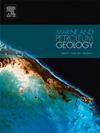Late Carboniferous to Permian paleoclimatic and tectono-sedimentary evolution of the central Ordos Basin, western north China Block
IF 3.7
2区 地球科学
Q1 GEOSCIENCES, MULTIDISCIPLINARY
引用次数: 0
Abstract
The Late Carboniferous to Permian is a crucial time epoch that witnessed multiple-stage icehouse-to-greenhouse transitions and amalgamation of the Pangea supercontinent in geological history. In the North China Block (NCB), a sequence of Late Carboniferous to Permian successions preserves dramatic changes related to these climatic and tectonic shifts. Here, we conducted a comprehensive study of sandstone petrology, mudstone whole-rock geochemistry, and detrital zircon U-Pb geochronology on Late Carboniferous to Permian strata in the Wuqi Oilfield, central Ordos Basin of the western NCB. Mudstone geochemistry and sandstone modal composition data indicate that sediments in the central Ordos Basin were deposited in arc/orogen-related tectonic backgrounds, with sources dominantly from erosion of intermediate-acid rocks. Detrital zircon U-Pb analyses yielded 3 major age populations of 2600–2200 Ma, 2100–1700 Ma, and 470–260 Ma, matching well with a northern Inner Mongolia Continental Arc (IMCA) source instead of a southerly Qinling/Qilian source. Three climate warming events were identified by increased levels of continental weathering. The τNa, CIA, and Ln (Al2O3/Na2O) values manifest two positive increasing events and, by reference, climate warming events, represented by high chemical weathering intensity (e.g., CIA >90 and τNa < −0.96), at ca. 302–298 Ma and ca. 292–290 Ma. The first event coincided with the deglaciation event of Gondwana triggered by the Skagerrak-Centered Large Igneous Provinces (LIPs). The second event was associated with the ca. 290 Ma large-scale glacial retreat in Gondwana that was synchronous with the Tarim LIP, Panjal LIP. The zircon Eu/Eu∗ empirical equation data indicates that the crustal thickness of the IMCA thickened from 40-43 km–50 km between approximately 320 Ma and 285 Ma. The increasing relief of the IMCA was recorded by ca. 280–260 Ma craton-wide sedimentary hiatus in the NCB interior. Subsequently, the high relief of the IMCA led to orographic rain shadow and aridification, which caused the third climate warming event, as indicated by the change in mudstone color from black to red.
求助全文
约1分钟内获得全文
求助全文
来源期刊

Marine and Petroleum Geology
地学-地球科学综合
CiteScore
8.80
自引率
14.30%
发文量
475
审稿时长
63 days
期刊介绍:
Marine and Petroleum Geology is the pre-eminent international forum for the exchange of multidisciplinary concepts, interpretations and techniques for all concerned with marine and petroleum geology in industry, government and academia. Rapid bimonthly publication allows early communications of papers or short communications to the geoscience community.
Marine and Petroleum Geology is essential reading for geologists, geophysicists and explorationists in industry, government and academia working in the following areas: marine geology; basin analysis and evaluation; organic geochemistry; reserve/resource estimation; seismic stratigraphy; thermal models of basic evolution; sedimentary geology; continental margins; geophysical interpretation; structural geology/tectonics; formation evaluation techniques; well logging.
 求助内容:
求助内容: 应助结果提醒方式:
应助结果提醒方式:


